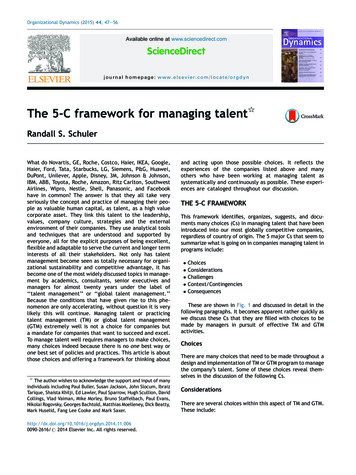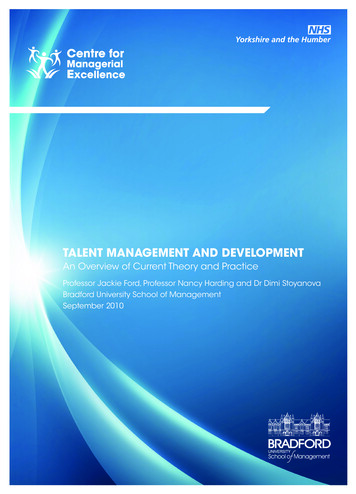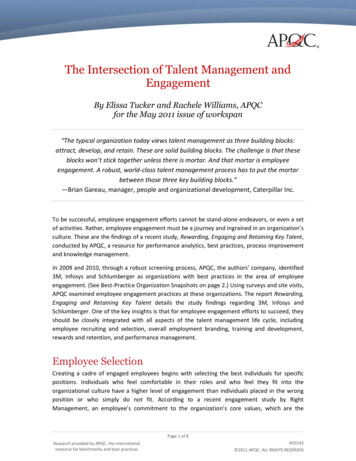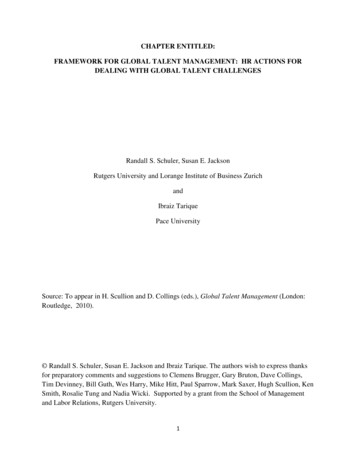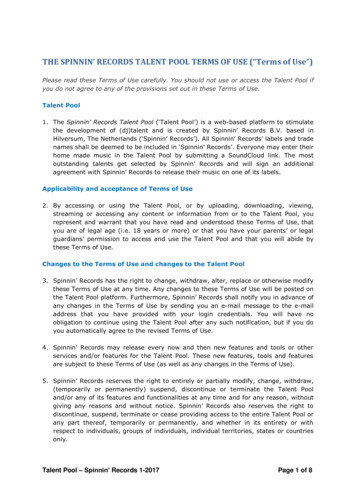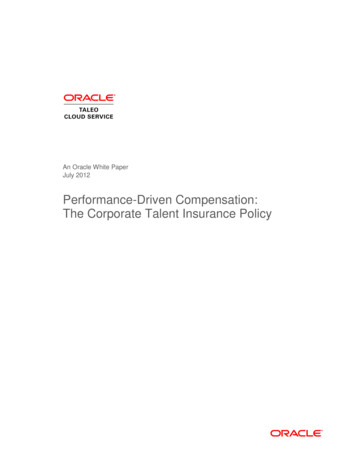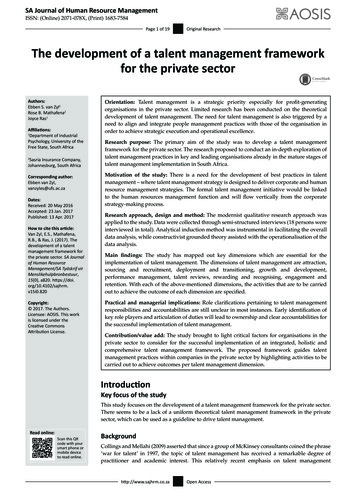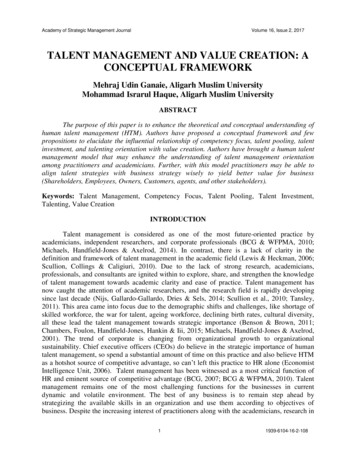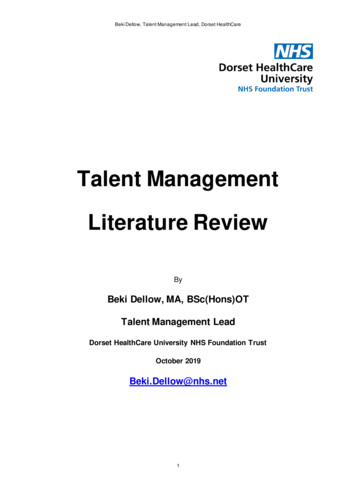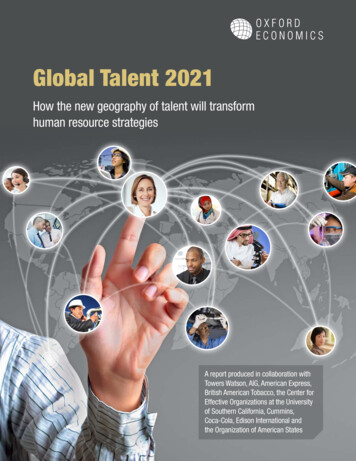
Transcription
Global Talent 2021How the new geography of talent will transformhuman resource strategiesA report produced in collaboration withTowers Watson, AIG, American Express,British American Tobacco, the Center forEffective Organizations at the Universityof Southern California, Cummins,Coca-Cola, Edison International andthe Organization of American States
Global Talent 2021How the new geography of talent will transform human resource strategiesExecutive summaryTectonic market shifts are transforming the global business landscape. Economicrealignment, advances in technology, the globalization of markets, changingdemographic trends, new customer needs and increased competition are radicallyaltering how companies operate in virtually every industry and region of the world.Evidence of this new world order can be seen in the trade numbers. In 1990, thetotal of the world’s exports and imports accounted for only 30% of the world’sGDP—today, they make up more than half.In 1990, the total of theworld’s exports andimports accounted foronly 30% of the world’sGDP—today, they makeup more than half.These structural shifts are reshaping both the supply and demand for talent acrossthe globe. To cope with a changing business environment, employers are demandingnew skills from their employees, yet often find they are in short supply. The paradoxis profound: On the one hand, 40 million workers in the industrialized world areunemployed, according to recent estimates by the International Labor Organization.Yet executives and managers tasked with hiring new workers often say they areunable to find the right people with the proper skills to fill their vacancies.Meanwhile, the sources from which talent might be recruited are also realigning.More talent is being “home grown” in the developing world, and as a result, ourforecast shows that over the next decade, new and sometimes unlikely regionsof the world will generate a surplus of talent. By contrast, other regions—like theUS and much of Europe—will confront the need to undertake a critical “reskilling”of labor to meet the new demands of a highly digitized and interconnected worldwhere higher skill sets will be required.To make their organizations more effective in the face of sweeping business change,HR leaders will need to rethink their techniques for managing talent and ensure theyare aligned with the new strategic objectives of their organization. Increasingly theywill need to develop more evidence-based approaches to manage global talent—drawing on improved analytics to identify talent segments and gaps, optimize resourceallocation, integrate workforce plans and manage unavoidable risk.Whether the issue is opening a new plant in a distant market, identifying the firm’snext set of corporate leaders, or preparing for a new customer strategy, the HRexecutive is emerging as a key strategic player proficient at using evidence-basedanalysis to influence corporate decisions. As Samira Kaderali, Director of StrategicWorkforce Planning at American Express puts it, “The notion of HR being muchmore analytic and data-driven provides a foundation for HR to be a strategic partnerto the business, to help drive business results—this is the conversation that all thebusiness and HR leaders want to have.”To help explore how market transformation will affect senior HR executives and thecompanies they serve, Oxford Economics undertook an extensive, two-prongedresearch program. We conducted a global survey of 352 HR professionals in the firstquarter of 2012, to examine how rapid globalization and the transformation of thebusiness environment will affect workforce needs in the future, and the implications ofthese shifts for senior business and HR executives. We also undertook an extensivemodeling exercise of 46 countries and 21 industry sectors to understand where the2OXFORD ECONOMICS
Global Talent 2021How the new geography of talent will transform human resource strategiesshifts in the supply of talent will occur over the next decade. To supplement the resultsof our quantitative research, we conducted a series of in-depth interviews with HRexecutives across the globe and drew on the expertise of our HR steering committee.Our research reveals not only that tomorrow’s landscape for global talent will bedramatically different than that of today, but that some countries and industries willneed to adapt more quickly to accommodate these rapid shifts. This report offersthe highlights of our analysis.Who took the survey?This survey was conducted in the first quarter of 2012, reaching a total of 352 human resourcesprofessionals around the world. Of them, roughly one-third were CHROs (Chief Human ResourceOfficers); another third were senior vice presidents, vice presidents or directors of HR; and therest were HR managers and analysts. About 22% came from companies with between 25 mand 250 m in annual revenue; 31% between 250 m and 1 bn; 23% between 1 bn and 5bn; 18% between 5 bn and 50 bn; and 5% over 50 bn. The survey reached executives in allregions around the world and represents a wide range of industry sectors.Figure 1: Survey respondent titlesWhat best describes your role in your firm?Director of HumanResources14.2%Chief HumanResourcesOfficerVice Presidentof HumanResources32.1%7.1%Senior VicePresident ofHumanResources12.2%Manager ofHuman Resources23.6%HumanResourcesSenior Analyst10.8%Source: Oxford Economics3OXFORD ECONOMICS
Global Talent 2021How the new geography of talent will transform human resource strategiesMarket transformation is redefining thesupply and demand for talentEverywhere across the globe, wrenching business changes are touching everyfirm and industry. Profound shifts in the global marketplace are ushering in a newera of complexity, uncertainty and change for companies. The rise of the internetand related technology has accelerated these market shifts, up-ending businessstrategies, models and processes along the way.“Our transformation hasreally shifted the way wethink about our businessstrategically.”Libby Wanamaker, GlobalDirector, ProgramDevelopment for Coca-ColaSurvey participants identify advances in technology (42%) and globalization (41%) aswell as shifts in labor demographics (38%), customer needs (38%) and competition(38%) as underlying forces that will have the biggest impact on their organization’stalent requirements in the years ahead. Even for firms that have operated across theglobe for decades, the issues are substantial and ever more complex. “Ultimatelyour company has come to terms with the fact that we are truly a global entity thatneeds to operate at both the global and local level,” explains Libby Wanamaker,Global Director, Program Development, Coca-Cola. “Our transformation has reallyshifted the way we think about our business strategically.”Business transformation requires new skillsAs a result of these rapid shifts in the market, the vast majority of companies areengaging in transformation initiatives to rethink their global strategies, business modelsand organizational approaches. Indeed, according to our survey, 41% have recentlycompleted a significant transformation initiative or are currently undergoing one. Andanother 47% of those surveyed are preparing to do so. For certain industries, such asfinancial services and heavy manufacturing, the total of those that have or plan to gothrough business transformation is even higher (more than nine out of 10).Figure 2: Transformation is pervasive across industriesPlease select the statement that best applies to your firm’s business transformation efforts.Recently completedCurrently undergoingPreparing to undergoNot avel andtransportationTICE 5bn 1bn0%20%40%60%80%100%% of respondents*TICE refers to the Technology, Information, Communications and Entertainment industriesSource: Oxford Economics4OXFORD ECONOMICS
Global Talent 2021How the new geography of talent will transform human resource strategiesThis transformation also requires a repositioning of employee skill sets, across alllevels of employment. Our study identified four broad areas where skills will be ingreatest demand. These include:1. Digital skills. The fast-growing digital economy is increasing the demand for highlyskilled technical workers. In particular, the emergence of social media is puttinga premium on developing new forms of digital expression and marketing literacy.According to our survey, of all technical capabilities, digital business skills are seenas most critical—particularly in Asia-Pacific, where e-commerce is mushroomingbecause of the early adoption of new digital technology as way to “leapfrog” aninefficient legacy infrastructure. In Europe, where economic conditions are weaker,the use of business software and systems to build internal efficiencies will continueto be a high priority.2. Agile thinking. In a period of sustained uncertainty, where economic, politicaland market conditions can change suddenly, agile thinking and the ability toprepare for multiple scenarios is vital. In industries that face significant regulatoryand environmental cross-currents, such as life sciences, and energy and mining,the ability to prepare for multiple scenarios is especially important—72% and 71%respectively, compared with 55% for the overall pool of respondents. To succeed inthe changing marketplace of the future, HR executives also put a high premium oninnovative thinking, dealing with complexity and managing paradoxes.Figure 3: Skills in high demand over the next five to 10 yearsDigital skillsDigital businessskillsAbility to workvirtuallyUnderstandingof corporate ITsoftware andsystemsDigital designskillsAbility to usesocial media and“Web 2.0”50.6%44.9%40.1%35.2%29.3%Ability toconsiderand preparefor multiplescenariosInnovationDealing withcomplexity andambiguityManagingparadoxes,balancingopposing viewsAbility to see the“big picture”54.8%46.0%42.9%40.9%15.3%Agile thinking skillsInterpersonal and communication skillsCo-creativity andbrainstormingRelationshipbuilding (withcustomers)Teaming(including virtualteaming)CollaborationOral and ty tomanage bility to workin multipleoverseaslocationsForeignlanguage Global operating skillsSource: Oxford Economics5OXFORD ECONOMICS
Global Talent 2021How the new geography of talent will transform human resource strategies3. Interpersonal and communication skills. Overall, HR executives believe thatco-creativity and brainstorming skills will be greatly in demand, as will relationshipbuilding and teaming skills. This reflects the continued corporate shift from acommand-and-control organization to a more fluid and collaborative style. Asenterprises of the future respond to the development of a “networked” corporateworld, where relationships with suppliers, outsourcing partners and even customersbecome more dispersed and nuanced, the capacity to align strategic goals, buildconsensus and encourage collaboration will become paramount. The challenge ismade all the greater because of the vast variety of geographies and cultures that willbe encompassed by tomorrow’s extended global enterprise.The most dramatic jumpin demand, according tosurvey respondents, willbe in emerging Asia,where the need for newemployees will rise 22%.4. Global operating skills. Reflecting the impetus of firms to expand in marketsaround the world, the facility to manage diverse employees is seen as the mostimportant global operating skill over the next five to 10 years. In the US, wherecompanies are embracing globalization and seeking to penetrate new markets,understanding international business was identified as the top global operating skillrequired. These operating skills will become even more important as globalizationenters its next phase. Indeed, according to Jeff Immelt, Chairman and CEO of GE,firms will increasingly move from “glocalization,” where home market products andservices are tailored to the tastes of overseas customers, to reverse innovation,under which innovation is led from emerging markets and then brought back hometo mature markets. Such global operating trends, which are already evidenced inboth life sciences and engineering firms, will require a global redistribution of keyskill sets.Permanent shifts in the business demand for talentAs firms contend with the transformation of their businesses, and the “reskilling”of their workforces, they must also prepare for long-term, permanent structuralshifts in demand for labor. Indeed, a new geography of talent will come to defineworkplace recruitment.The demand for workers is already more pronounced in emerging markets thanksto continued brisk growth in most of these economies. The most dramatic jumpin demand, according to survey respondents, will be in emerging Asia, where theneed for new employees will rise 22%. Other emerging markets that will see aboveaverage growth in demand are Latin America (13%), Middle East/Africa (13%) andEastern Europe (10%).Demand for talent in Western Europe, by contrast, is projected to grow a rathermodest 3.5%, according to our survey. In some industries like business services,energy, travel and transport, and life sciences, staffing demand will actually declineas Europe copes with its ongoing debt crisis and austerity-driven recession.Somewhat stronger job demand is expected in North America, where surveyedexecutives expect overall employment requirements to rise 6.1% over the next fiveto 10 years as a result of more resilient economic conditions.6OXFORD ECONOMICS
Global Talent 2021How the new geography of talent will transform human resource strategiesFigure 4: The future demand for talentHow will the landscape for talent change over the next five to 10 nEuropeMENALatinAmericaEmergingAsiaTotal 2.2%-11.9%33.0%Travel andtransport-9.3%-1.4%36.5%5.0%14.1%32.9%32.6%Life sciences-4.1%4.2%8.2%19.7%8.6%20.4%16.6%Source: Oxford EconomicsThe outsourcing of manufacturing jobs from the developed to the emerging worldand the long-term effects of the financial crisis of 2008 means employment incertain industries is likely to shrink permanently in mature economies. In the USalone, Bureau of Labor Statistics data clearly illustrates that the sharp declinein construction and manufacturing that resulted from the financial crisis was notfollowed by a rapid “snap back” after the crisis passed, as was typical of previousrecessions. In part, this reflects the rising competitiveness of emerging markets inlow skilled manufacturing. Similarly, demand for industrial workers in emerging Asiais expected to rise 37.7% and in Latin America by 17.1%, while in North Americademand is forecast to decline by 2.4%.Figure 5: US employment by sectorChange in employment by sector (in ial servicesOtherProfessional andbusiness uJan’08-2500Source: Bureau of Labor Statistics7OXFORD ECONOMICS
Global Talent 2021How the new geography of talent will transform human resource strategiesThe talent pool moves from industrial to emerging marketsIn the last decade, rapidly growing nations like India and China siphoned off manylow-wage and relatively unskilled manufacturing jobs from the developed world,causing dramatic dislocations. In the coming decade, these nations will move upthe skills ladder as they improve access to high-quality education. A demographicbulge, accelerating economic growth and technology-enabled training will alsocontribute to the dramatic rise in the number of college-trained talent developingmarkets are expected to produce. Of the major emerging markets, the fastestannual talent pool growth will be in India (7.3%), followed by Brazil (5.6%), Indonesia(4.9%), Turkey (4.7%) and China (4.6%).Over the next decade, thepercentage of collegeeducated talent will riseto 60% in the E7—some217 million workers, asopposed to 143 million inthe developed world.But for many developed countries, particularly in Europe, the next decade will seea further slowdown in population growth and continued aging of the workforce.Paradoxically, the biggest losers may be economies that have made the greateststrides in tapping potential talent by increasing access to education and raisinglabor market participation, since they will have less scope to boost talent supply.At 1.4% and 1.3% a year, respectively, the US and Canada will lead the G7 inannual talent growth, while France (0.9%), UK (0.7%), Italy (0.5%), Japan (0.4%) andGermany (0%) will lag.The impact of the global distribution of talent will be dramatic. Already, over half ofthe world’s college graduates (54%) come from the top emerging markets (the E7:Brazil, China, India, Indonesia, Mexico, Russia and Turkey), compared with 46%from the industrialized world (the G7: Canada, France, Germany, Italy, Japan, UKand US). Over the next decade, the percentage of college graduates will rise to 60%in the E7—some 217 million workers, as opposed to 143 million in the developedworld. Perhaps most tellingly, China will overtake the US as the country with thelargest single pool of educated talent.Figure 6. Growth in the college-educated talent poolTertiary educated (“talent”): E7 and G7 %6%7%8%% growth 2010–2021Source: Oxford Economics8OXFORD ECONOMICS
Global Talent 2021How the new geography of talent will transform human resource strategiesFigure 7. Size of college-educated talent poolTertiary educated (“talent”): E7 and G7 pan7%Russia11%India13%US25%Note: “Other” contains those withless than 2% of the total, includingCanada, France, Germany,Indonesia, Italy, Turkey and the UK.Source: Oxford EconomicsWill supply meet demand?Developing nations understand that as technology changes rapidly and diffusesreadily, sustained investments in education and training can pay off by helping youngworkers in their countries become critical players in future waves of innovation.There is no ironclad rule mandating that areas like the Silicon Valley in the USwill be the only home of future innovation and job creation, as nations like Chinaand India invest in industries ranging from life sciences to renewable energy andspace exploration. In fact, eight of the top 10 countries likely to boast the largesttalent surpluses a decade from now will be in the developing world, led by India,Indonesia, Colombia and South Africa. Even though these countries are expectedto experience robust economic growth, more skilled workers will be produced thanjob opportunities will appear.With the digital divide now operating in reverse, the South, rather than the North,could become the major source of technical talent a decade from now. Moreover,as the flow of capital and technology becomes increasingly frictionless across theworld, centers of innovation and product development are likely to spring up inpreviously unheralded regions.Cummins Inc. has experienced this shift firsthand. An engine manufacturer withoperations in 52 countries, Cummins now generates over 60% of its revenue fromits foreign operations, yet until recently ran its lone engineering center from itsheadquarters, in Columbus, Indiana. As new plants open in fast-growing marketslike Brazil and Turkey, HR executives like Paul Wright, the company’s Global DiversitySpecial Projects Manager, will need to recruit the right talent to fill those newlycreated jobs, and standardize job categories that exist in different geographies. “HRis at the center of planning now,” says Mr. Wright. “We’re trying to make it easierto identify and move talent around the world as we need it and to help offer peopledevelopment opportunities.”9OXFORD ECONOMICS
Global Talent 2021How the new geography of talent will transform human resource strategiesMeanwhile, labor shortages are projected to appear in many mature markets, includingthe US, Germany, Canada and Italy, in part because of their aging populations andbecause much of their population is already relatively well-educated, offering lessroom for meaningful improvement. Faced with recession and budget constraints inthe wake of the 2008 economic crisis, many of these countries will fall further behindin the race between education and technology.Figure 8: The mismatch between supply and demand for talent in .6-0.6-0.6-0.6-0.5-0.4-0.5-0.4-0.4Strongest trendtalent 20.40.20.60.50.70.60.81.00.81.11.02.1Demand and supply fortalent in balanceInd Indio aC nesSo olom iauth biAfr aicBr aMo aziCz roc lec cohReEg p.ypQa ttaCo Pe rsta ruRBa icahrainPhUSa illipp AEud ineiA sBa rabirb aMa adoslayKu siawaO itBe manrmudC aArg hinen atMe inaxicRu ossSw Sp iaitz ainerlanNe Aus dthe triarlaSw ndseAu denstrNo aliarTh waySin ailanga dGe porermaFra nyncTu erkeyUKUSSo Can Auth adKo aGr reaeecCh eileItPo alylanJa dpTa aniwan1.5Strongest trendtalent surplusSource: Oxford EconomicsNotes1. The table ranks countries according to how their talent gaps are expected to evolve over the next decade.2. Talent deficits are shown as red (negative numbers), talent surpluses as green (positive numbers), andbroad balance as yellow.3. Numbers report the average annual % change of the deficit/surplus.A closer examination of two major economies, India and China, help illustrate thedynamic forces at work in this new landscape for talent. On our “heat map” outliningthe projected balance of supply and demand for skilled labor, China is shown inbalance: Its heavy investment in education will enable it to meet its talent needsand sustain its rapid economic development, even as its population growth levelsoff and its population begins to age. Its projected 4.6% annual increase in collegeeducated talent will roughly match its economic growth.“In China we don’tencounter a problem interms of ‘supply.’ Theissue for us and manymultinationals is how tofoster their loyalty andengagement longer-term.”Randall Bradford, InternationalVice President for HumanResources, Medtronic10For Medtronic, the world’s largest medical technology company and maker ofpacemakers, defibrillators, stents and other medical devices, China is expected tosomeday become the firm’s largest single market. Randall Bradford, InternationalVice President for Human Resources, says the firm has found the market forqualified workers very rich: “In China we don’t encounter a problem in terms of‘supply.’ There is plenty of well-educated talent there. The issue for us and manymultinationals is how to foster their loyalty and engagement longer-term.”India, by contrast, is projected to top the country rankings in terms of its surplusof educated talent. This surplus results from its young and rapidly growing pool ofworkers and some educational improvements (although much less dramatic thanin neighboring China). While India’s pool of college-educated talent is expectedto rise more than 45 million in 10 years, it will exceed that which can be absorbedby the Indian economy. This will compress the wage premium for talent, allowingfor investment in new technologies and business models that will fuel growth wellbeyond 2021.OXFORD ECONOMICS
Global Talent 2021How the new geography of talent will transform human resource strategiesFigure 9: Employment growth in IndiaChange in employment by sector since 2008 (in onManufacturingTradeOther n is already experiencing a decline in overall population, while its demand fortalent will increase modestly. Its supply of educated talent will expand by only 0.4%over the decade. Since Japan’s economy is largely closed to immigration of largenumbers of skilled managers and technicians, the net result is that Japan’s talentdeficit is expected to be second largest in 2021 among the nations studied. Indeed,nine of the 10 countries projected to experience the most pronounced talent deficitswill be industrialized nations.Figure 10: Global Heat MapThe gap between the growth in demand and the growth in supply of talent, 2011 to 2021(Red indicates a trend deficit, green a trend surplus, yellow a broad balance. Numbers show trend growth as annual percentages.)-0.5-0.1-0.9-0.4-0.8-0.4-0.6 -1.20.8-0.4 011-0.11.0OXFORD ECONOMICS
Global Talent 2021How the new geography of talent will transform human resource strategiesManaging the talent mismatchThe talent mismatch—between where talent is most needed and where it will be mostavailable—is not likely to evaporate soon. Managing this skills gap in the developedworld and recruiting appropriate talent in the emerging economies will becomea critical task for global firms in the future. In the developed world, where talentshortages in a number of managerial and technical fields are expected to persist,companies will be forced to think more explicitly about the trade-offs betweenoutsourcing work, off-shoring staff and retraining workers. Likewise, decisionsabout where to locate new centers of innovation, product design or advancedengineering may become focused on geographies not previously considered bythe C-suite. Firms will also need to become more proactive about partnering withrelevant government and educational institutions to develop and train workers, asthey come to anticipate more accurately their turnover and retention rates and theirfuture workforce demands.An example of one forward-looking firm is Lenovo, the China-based computermaker. To support its global growth, Lenovo is partnering with top-ranked Chineseuniversities to identify top talent that may have gone abroad to study, but might beinterested in returning to work in the motherland. “We’re looking to build that talentpipeline three or four years down the road,” explains Robert Gama, the firm’s VicePresident of Human Resources. “If we continue to outpace the market and becomethe leading PC vendor in the world, we will need to double the number of ourleaders across the company. We are always looking to attract the best talent aroundthe world.”12OXFORD ECONOMICS
Global Talent 2021How the new geography of talent will transform human resource strategiesRethinking HR strategies for the newglobal marketplaceA more analytical,evidence-based approachwill not only lead to betterHR results, but willgenerate greater supportfrom senior managementwho require soundbusiness cases formaking decisions.Business transformation and the new geography of talent will call for a fresh HRapproach and mindset. To manage the enormous change process, HR executiveswill need to use new analytical tools to understand and plan for the future, assessthe impact of decisions, optimize performance, prepare for different scenariosand align talent management with larger corporate strategies. A more analytical,evidence-based approach will not only lead to better HR results, but will generategreater support from senior management who require sound business cases formaking decisions.“For the last 15 to 20 years we’ve focused HR leaders on efficient delivery of services,”says Ravin Jesuthasan, Talent Management Practice Leader for the consulting firmTowers Watson and co-author, with Dr. John Boudreau of the Center for EffectiveOrganizations at the University of Southern California, of Transformative HR: HowGreat Companies Use Evidence-Based Change for Sustainable Advantage. “Todaythe opportunity is for HR to transform how firms manage talent, enabling businessleaders to make better decisions about human capital.” Integrating these new HRtools can help firms optimize their talent and boost employee performance.Building on the transformative principles outlined in this book, our research revealsfive important steps firms should take to retool HR for the changes ahead.1. Use more sophisticated analytical tools for making global decisions.Over the next three years, companies will increasingly rely on logic-driven analyticsto make better decisions about the supply and demand of talent. According to Dr.Boudreau, “under a logic-driven approach, firms should identify the most pivotalorganizational issues and use robust analytics to describe the issues and assess thelikely outcomes.” Best practice will entail the consistent use of analytics to generateinsights, test alternatives, monitor progress and measure business impact.As firms globalize, they will also need globally integrated HR data systems. Our surveyshows that the use of data from globally integrated HR information systems (HRIS) willrise from 39% to 47%, and from regional or divisional HRIS from 40% to 46%. Whileless than half of our survey respondents say their HRIS are integrated today, 63%say they will make this transition in the next three years. And while only 52% of firmstoday say they possess a “strong understanding” of the HR metrics that matter to eachbusiness unit, 65% of respondents expect this to be true in three years.More rigorous data analysis offers firms many benefits. For ATK, a global defense,aerospace and commercial products company headquartered in the US, analyticaltools are crucial for workforce planning. “Our data analysis allows us to be proactiveand forward-looking in recruiting,” says Carl W
Director, Program Development for Coca-Cola Market transformation is rede ning the supply and demand for talent Everywhere across the globe, wrenching business changes are touching every rm and industry. Profound shifts in the global marketplace are ushering in a new era of complexity, uncertainty and change for companies. The rise of the .

